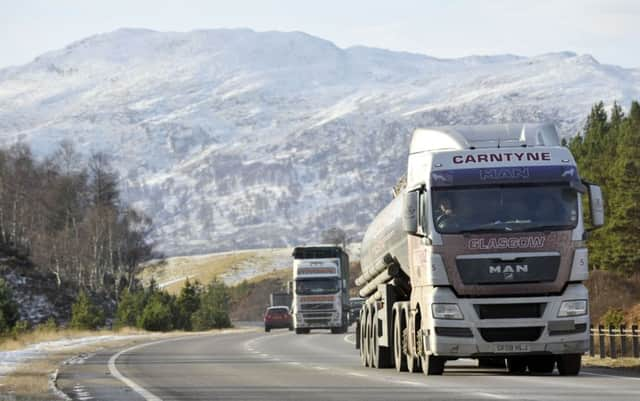Stretch restrictions to the safest limit


David Spaven of the Rail Freight Group (RFG) stated in an article on these pages that plans to increase lorry speed limits A9 on the could damage plans to boost train services. This was followed by a press release criticising transport minister Keith Brown for “caving in” to the road haulage industry’s interests and giving lorries an unfair advantage when he announced a three-year trial of 50mph on the single carriageway sections.
The RFG article claimed that research shows that big reductions will be achieved in enforcing a 40mph limit on HGVs. Since then, more research and modelling work has been done using the most up-to-date techniques and the differential in fatal and serious accident rates between 40mph and 50mph is now reduced very considerably from the previous modelling work.
Advertisement
Hide AdAdvertisement
Hide AdOne could also say that if the limit was set at 30mph there would be even fewer accidents, and even less if it was reduced to 20. Road safety is, of course, extremely important – but a sensible balance has to be struck and the trial will demonstrate whether the roads are safer when HGVs go at 50mph on single carriageway stretches of the A9. The haulage industry firmly believes that this will be proven.
Having a gap of 20mph maximum speed differential between trucks and other vehicles would have proved too dangerous in terms of frustrated car drivers having a stop-start journey leading to risky overtaking manoeuvres.
Indeed an earlier study by Transport Scotland called for a trial to be held and stated that the current speed differential was leading to queues forming behind lorries with all too predictable consequences.
It is relatively easy to be selective in picking out points from research which suits one side’s case. In both the recent research and the earlier study, there are numerous pointers that reducing the differential would reduce accidents. Experience in the last decade in New Zealand (a country of similar topography) where the HGV speed was increased to 90 kilometres per hour (56mph) led to a decrease in accidents. Modern lorries are far better equipped from a safety point of view than they were half a century ago when the outdated 40mph limit was set. It should also be noted that buses are already allowed to go at 50mph on these stretches of road – and they carry a very special cargo.Mr Spaven also points out that lorries over 7.5 tonnes are involved in 23 per cent of the accidents whilst making up only 7 per cent of the traffic. Being involved does not mean being the cause or at fault. Accidents involving lorries are reducing year on year.
There are expectations of the lorry drivers during the trial.
This includes leaving plenty of space between vehicles to allow safe overtaking, to give cars priority to overtake on short sections of dual carriageway and the 2+1 sections and to be courteous to other road users at all times. Most drivers do this already.
When the trial is over, I am sure that an increase to 50mph will be shown to be both good for road safety and good for business. More to the point, this is the overwhelming view not only of RHA members but also of their drivers who are best placed to see the consequences of an artificially low speed limit.
Finally, on Mr Spaven’s point about the effect on rail freight, the Road Haulage Association is in favour of goods moving by rail where appropriate and indeed RHA members are at the forefront of delivering rail freight services across the UK including the length of Scotland.
Advertisement
Hide AdAdvertisement
Hide AdThe railways are also quite rightly getting a good deal of investment in Scotland – we can readily co-exist together. I’m surprised in fact that David comes across as so feart.
Many of the lorries using the A9 do not travel its full length. They have deliveries along the route or they are starting their journey along the route and rail freight would not be a cost effective option for them. Many types of goods, including livestock, could not be transported by rail at this time either.
The rail-freight sector needs to stop objecting to marginal increases in road haulage efficiency and concentrate on improving efficiency and quality of their own services.
Road haulage is, and will remain, a vital service to the people and businesses in Scotland as a whole and especially the north of Scotland.
• Phil Flanders is director, Scotland and Northern Ireland, Road Haulage Association: www.rha.uk.net
SEE ALSO